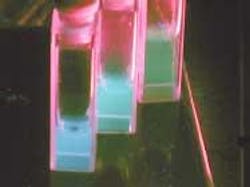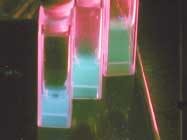Gold nanoclusters emit at discrete wavelengths
Gold (Au) nanoclusters dissolved in water by researchers from the Georgia Institute of Technology (Georgia Tech) and Emory University (both of Atlanta, GA), and Furman University (Greenville, SC) behave like multielectron artificial atoms, emitting at discrete wavelengths in the visible and IR with the wavelength increasing with the size of the cluster, for example solutions of five-atom (left), eight-atom (center), and 13-atom clusters (right). Correlation of nanodot sizes with emission energies fits the “jellium” (conventional electron-gas) model and provides a previously missing link between atomic and nanoparticle behavior in noble metals. Application possibilities include biological labels with narrower excitation spectra, smaller particle size, and fluorescence comparable to systems based on semiconductor quantum dots; energy-transfer pairs; and light-emitting sources in nanoscale optoelectronics.1
The gold nanodots are made up of 5, 8, 13, 23, or 31 atoms, each size fluorescing at a different wavelength to produce ultraviolet, blue, green, red, and IR emissions, respectively. The fluorescence energy varies according to the radius of the quantum dot, with the smallest structures the most efficient at light emission. Quantum dots made from semiconductors such as cadmium selenide are much larger, containing hundreds or thousands of atoms. Semiconductor quantum dots obey different size scaling under confinement, producing weaker emissions.
Because of their narrow excitation spectra and small physical size, the gold quantum dots could be particularly useful in fluorescence-resonance energy-transfer (FRET) systems, in which emission from one nanodot would be used to excite another as a means of measuring proximity. The broad excitation spectra of semiconductor quantum dots and their larger size make them more difficult to use in FRET-based research, according to Robert Dickson, an associate professor in the Georgia Tech School of Chemistry and Biochemistry.
By using poly-amidoamine (PAMAM) dendrimers to encapsulate their gold clusters, the researchers produced quantum dots with very clean mass spectra. The eight-atom cluster, for instance, produces bright blue emission and fluorescence quantum yields of 42% in an aqueous solution. The researchers produce the nearly spectrally pure, size-tunable gold nanodots through a slow reduction of gold salts within aqueous PAMAM solutions, followed by centrifuging to remove large nanoparticles. By controlling the relative concentration of gold to PAMAM and the generation of the dendrimers, the researchers can control nanocluster size-and therefore the emission wavelengths. The nanodot solutions are stable, lasting for months either in solution or as dried powders. Solutions from redissolved nanodot powders have the same properties as when they were originally created.
Before these gold quantum dots can be useful in biological labeling, however, the researchers must develop a mechanism for attaching them to proteins that scientists wish to track in cells. “We will need to determine ways to functionalize these quantum dots so they will get across cell membranes, seek out specific proteins inside a cell, and label those proteins,” Dickson said. “We are basically developing the tools for in vivo single-molecule sensitivity and labeling in living systems in the presence of very high backgrounds. We expect to produce a new set of probes that will be size-tunable, nontoxic, and very bright.”
REFERENCE
1. J. Zheng et al., Phys. Rev. Lett. 93, 077402 (Aug. 13, 2004).

